There’s An Important Story Behind Those Pictures Of Neon-Lit Apartment Windows
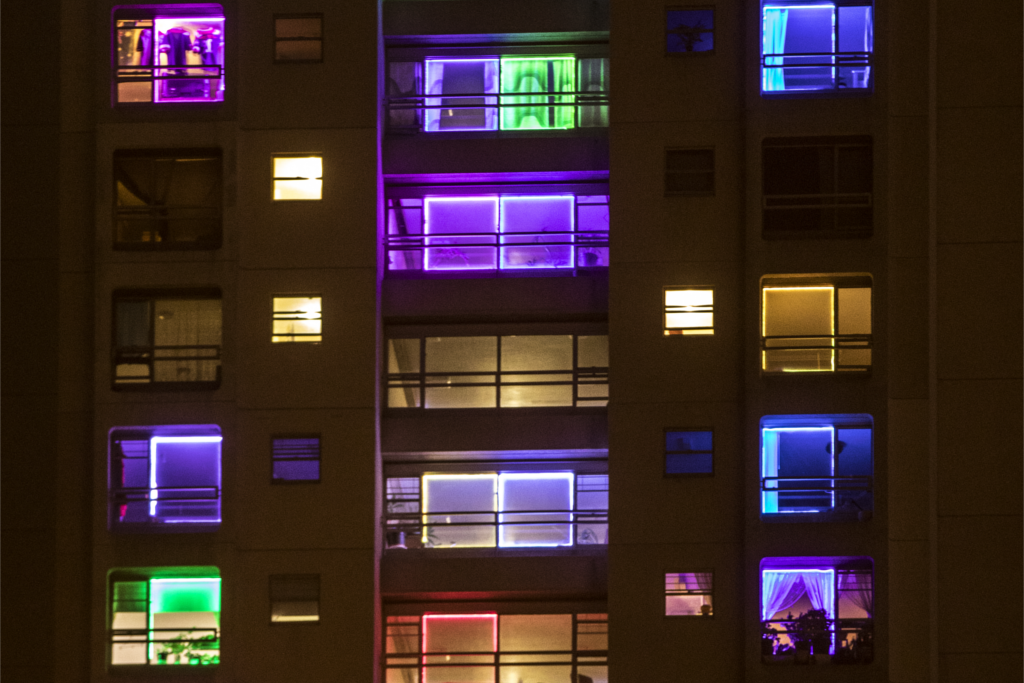
There’s a picture you might have seen on social media of late. If you ever spend time in Sydney’s Redfern or Waterloo at night, you might also have seen it in person.
It’s an image of two drab grey concrete towers, with a smattering of windows lit up in neon hues. It looks a bit like a light-up dancefloor superimposed on a building, or else a multi-storey game of Tetris. If you’ve never seen these towers before, you might reasonably expect it to be part of the Vivid festival, something there to be Instagrammed.
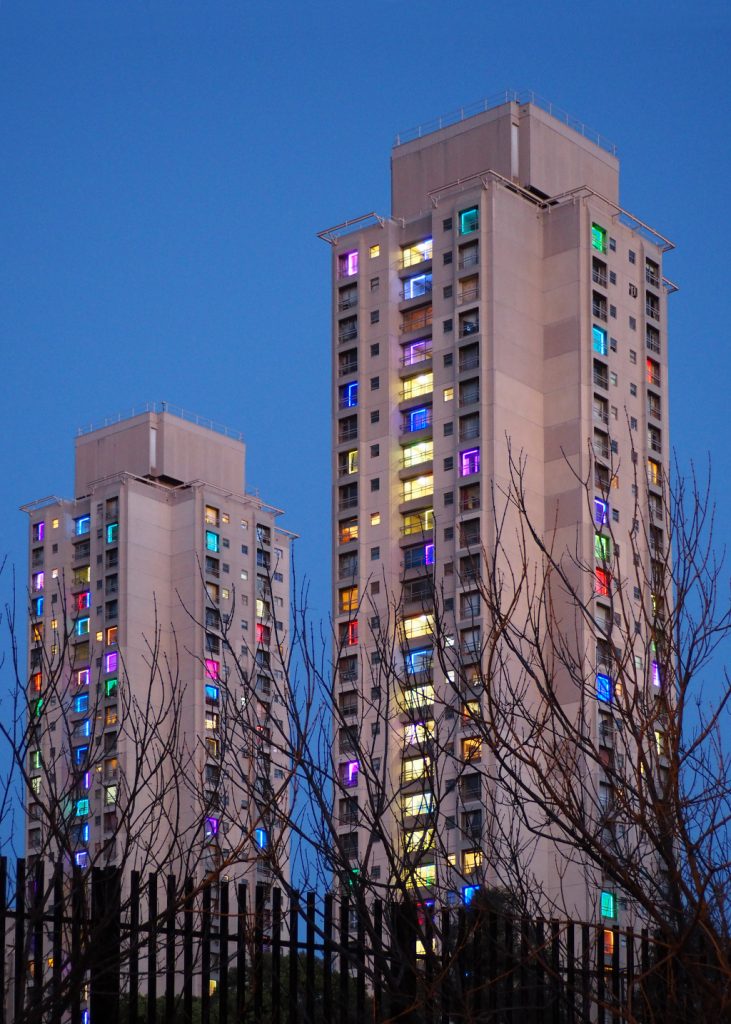
Photo by Carol Tang, courtesy of We Live Here 2017.
You’d be partly right. The lights are there to be Instagrammed — the organisers strongly encourage it. This is because the lights are part of a protest; a public art project spanning one of Sydney largest remaining inner-city public housing estates.
If the government gets its way, the towers will soon be demolished to make way for development. Every neon square is the window of a resident who doesn’t want that to happen.
They want your attention. And thanks to the lights, they have it. The project, known as We Live Here 2017 (2017 being the postcode of Waterloo) aims to highlight the community of Waterloo before it’s gone; maybe even to save it, if the Government is unexpectedly receptive. Here’s what they want you to know.
Every Light Is A Relationship: Meet The Residents of Waterloo
Clare Lewis is often credited as “the artist” behind the project. But while she helped come up with the idea, bankroll and coordinate the endeavour, she’s hesitant to take credit.
For Clare, the appeal of the project is that it’s “sort of the opposite of a Vivid Sydney display, where one graphic designer’s visions or abilities are being projected onto it. This is actually emitted from the inside of the building, with every light installation being a relationship.”
“Relationship”, in this case, is not a metaphor. Each of the 265-odd windows that light up every night is the culmination of a long process. Clare or another volunteer have spent months knocking on doors and distributing multilingual pamphlets to residents, and then talking to them about the project and what it means. Residents are free to say no, and some do, but many are drawn to tell their story and become part of something bigger.
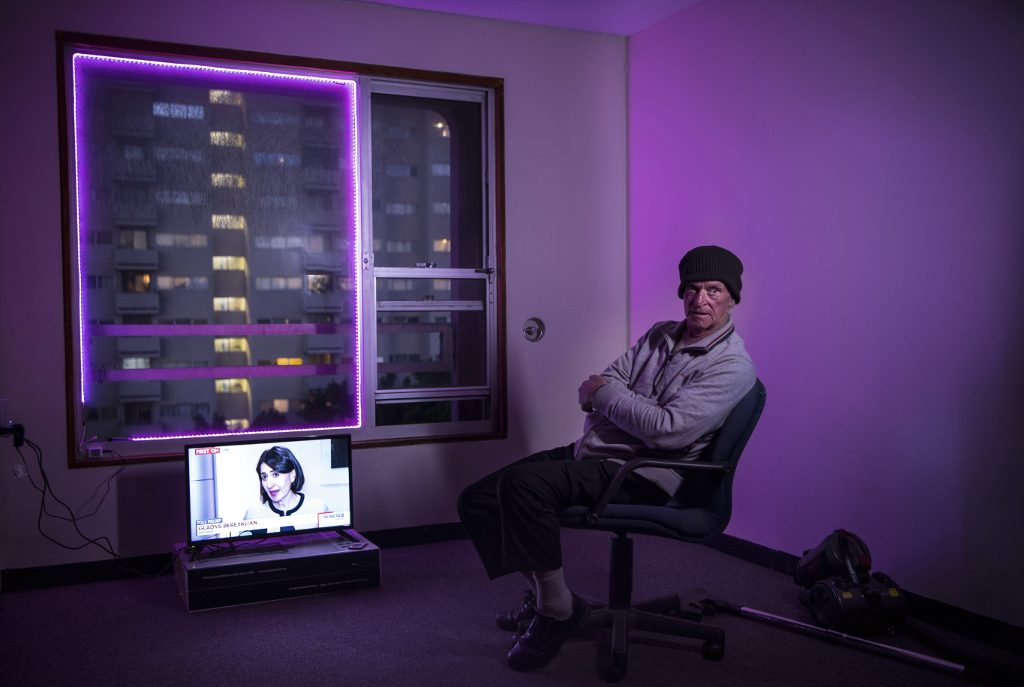
Image by Nic Walker, courtesy of We Live Here 2017.
“You have to gain the trust of the person, show them the bigger picture idea and get them across the line,” Clare says. “And then you’ve got to scrub down their windowsill, move around various bits of furniture, fit the lights.”
“It’s a lot of LED strip, and a lot of conversation, and a lot of methylated spirits [for cleaning],” she says. “But it’s a real honour to speak to the residents.”
Ross Davey, a resident in the Turanga tower, has been on the receiving end of that conversation, and feels pretty similarly. He got involved when he stumbled across an organising meeting in the building’s foyer and liked what he heard — sadness about the proposed redevelopment, optimism about the community’s power to do something.
Now every light he lights his window up in gently shifting mauves and purples — “the most satisfying setting,” he says, “unless I’m partying and I want to compete with the lady across the canyon in the other building, in which case I have it flashing and strobing.”
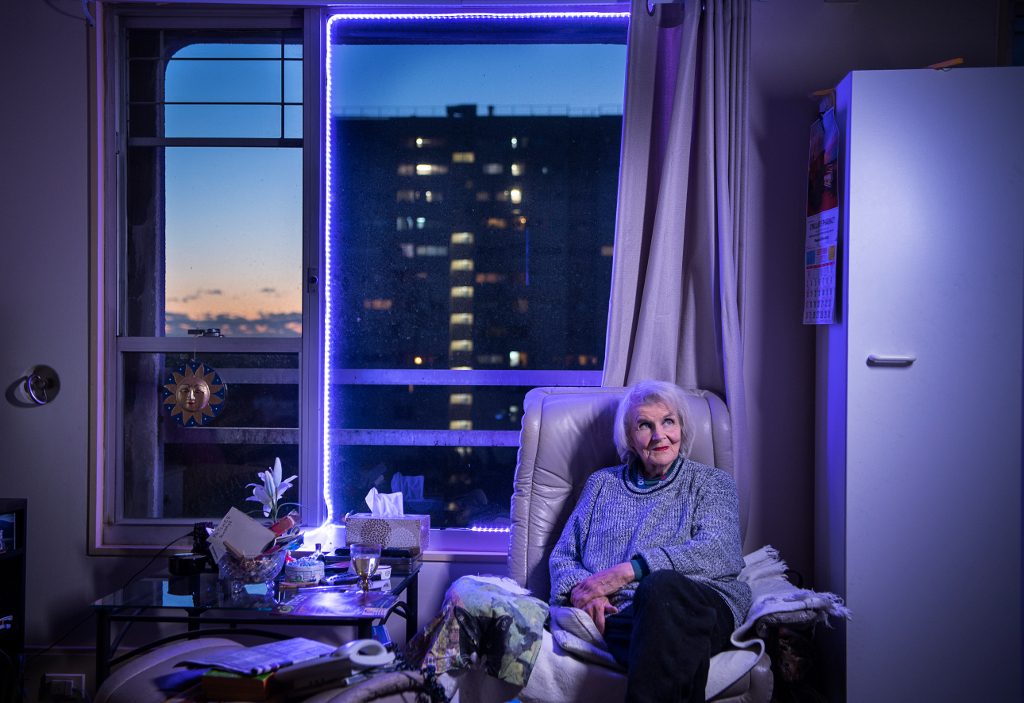
Photo by Nic Walker, courtesy of We Live Here 2017.
Ross hasn’t lived in Waterloo long — around two-and-a-half-years by his count. “Moving in, at first I was a bit apprehensive,” he says. “It was because of some of the stories I’d heard, and some of the names that the towers have had in the past, which I won’t repeat.”
Felix Scerri, who has lived in the neighbouring Matavai tower for five years, does not similarly mince words. “They called our towers the suicide towers a couple of years ago. The media normally gives us a pretty bad rap.”
For Ross and Felix and many of the other residents Clare has spoken to, this description couldn’t have been further from the truth. Rather than the bleak corridors they had expected, many of the towers’ residents have found a community they love and treasure. “We take care of each other, you know,” Felix says. “If you haven’t seen someone for a while, we’ll all try to find out what’s happened to them, make sure everyone’s okay.”
It’s a community that’s only grown closer since the lights started flickering on in June. “It’s helped a number of residents of the towers,” Ross tells me. “People have started conversations, I’ve got to know people a bit better, and I really feel like part of the community. I like it here.”
The End Of Inner-City Public Housing
Letting people know they like it at Waterloo has been a frustratingly uphill battle for residents. As Felix pointed out, mainstream media has painted a bleak picture of the towers in past, selling them as decrepit cesspools of mental illness, loneliness and crime.
When the residents were first told of the planned redevelopment in 2015, the government letter informing them of the impending changes infamously opened with “I am excited to let you know” — the assumption being, as Clare puts it, “that everyone was unhappy with their circumstances at Waterloo — that no one could possibly want to live there”.
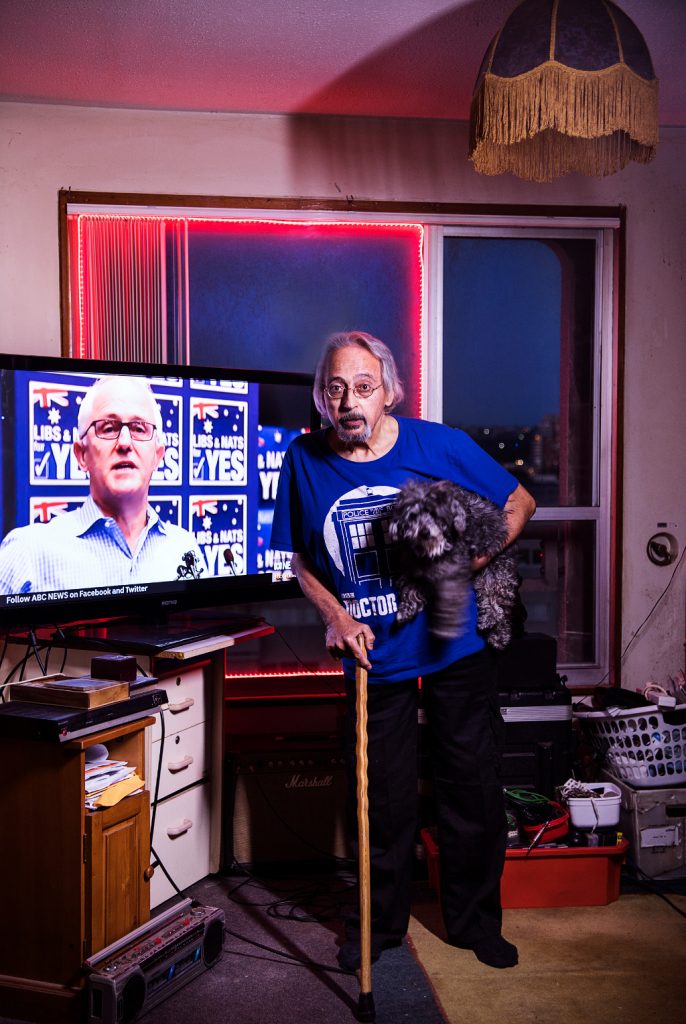
Photo by Nic Walker, courtesy of We Live Here 2017.
It’s a pretty common story in public housing in Sydney at the moment. The Sirius Building in the Rocks has been progressively cleared of residents over the last few years; two remain, and their future is uncertain. Inner-city public housing buildings are variously described as ugly or dangerous despite residents’ accounts that they are good places to live. The good bits drop out of media coverage, or become the very reasons public housing residents are unworthy of the spaces — the beautiful trees and open green park around the Waterloo towers only ever seem to be mentioned when making a case for the towers as a waste of space.
As Waterloo Public Housing Action Group volunteer Karyn Brown wryly puts it, “if it’s got a bit of green space, they can’t just leave that sitting there, can they?”
Karyn lives in public housing near the Waterloo towers, and has been helping to install the light project. Her home is also threatened by the redevelopment, and she’s angry about it, above all because it seems like a waste. Waterloo’s green spaces are just beginning to bloom. Many of the buildings were only built in the 1970s, and have held up well over the years. The reasons to keep the public housing estate intact are numerous, and the reasons to remove them so flimsy — one of the biggest justifications of the redevelopment is a new metro station, despite Waterloo being only a few hundred metres from Redfern, one of Sydney’s largest stations.
“Personally, I think right from the start it’s pretty much been ‘you people don’t deserve all this space, you don’t deserve all this amenity, so we’re going to move you,” Karyn says. “That’s my personal feeling — that they just think we do not matter, and basically they can put us in a box anywhere and we should be grateful.”
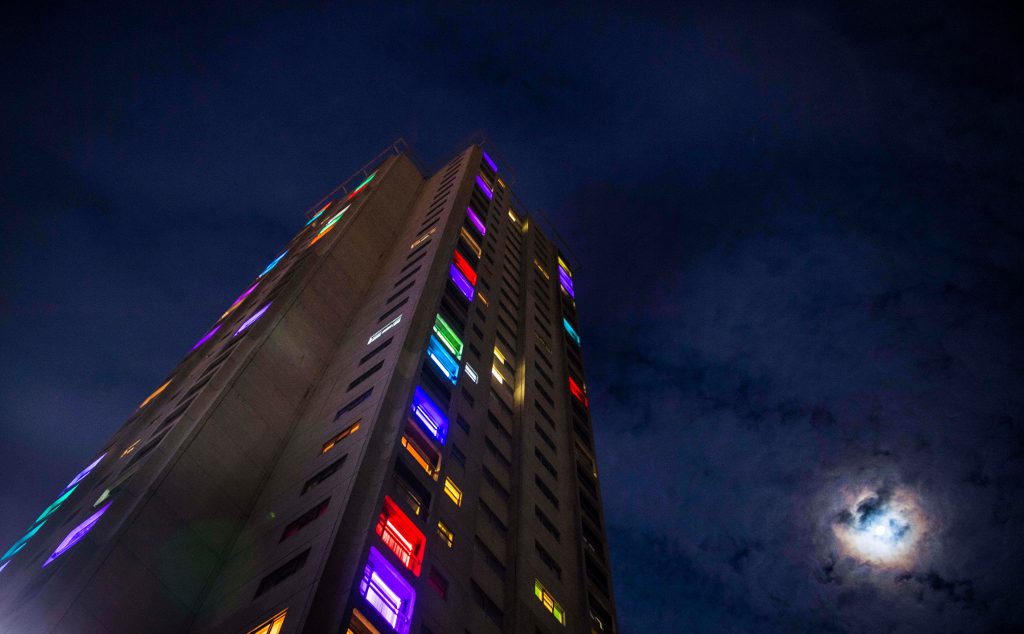
Photo by Nic Walker, courtesy of We Live Here 2017
“A box anywhere” usually means being rehoused outside the city while developments take place, which for older residents can very easily mean permanently. The plans for Waterloo aren’t finalised, so residents don’t know when they’ll begin, or when they’ll be affected. The redevelopment will contain a mix of public and private housing, but the balance of that mix and the timeframe for its completion is unclear. Residents described a “cloud of uncertainty” since the initial announcement in 2015, and one that’s causing a lot of stress for the significant portion of the community who need or want to remain in the city.
“They say they’ve got all these places out in the suburbs, and they say ‘you’ll love it’,” Karyn tells me. “But we won’t. I won’t. People still want to live in the city, and they will live on the streets if they have to.”
“Covering the place in unaffordable housing is a disaster, a really long term disaster. It will take a lifetime to fix, if it’s fixable.”
Ross is also not interested in moving. He’s lived in the city his whole life; his work, first as a taxi driver and now in food delivery, is tied to the city streets he loves. His doctors are here, his community is here. He doesn’t want to leave, but feels like the government isn’t interested in hearing him out.
“It feels like social engineering is going on. It’s a bit of a sobering thought — do they want to turn cities into just enclaves for the ultra-rich” he tells me. “But then where are they going to put all the people? Are they going to put us out at Penrith, or where? There’s nowhere left to go.”
We Live Here: Listen To Us While You Can
Every night, hundreds of windows at Waterloo light up according to the whims of the people behind them. Each of these people has their own reasons for getting involved, and their own hopes for what the project might ultimately achieve.
Some of the people we spoke to wanted the lights to combat the towers’ negative media portrayal; others just wanted their stories heard. For some, the lights are a goodbye to a home they’re preparing to leave; for others, they’re a last-ditch warning, a final attempt to seize on some kind of beacon that will get policymakers’ attention, maybe even save some of Sydney’s public housing before it’s too late.
The residents we spoke to varied in their levels of optimism about these outcomes. But they agreed on one thing, and that was that one of the most unexpected, and most powerful aspects of the light project, has been bringing together the community. For them, the lights have highlighted Waterloo’s potential rather than its decline; the value of a community that can’t easily be replaced.
“It’s started conversations, it’s built trust,” Ross says of the project. “It hasn’t been like utopia, there’s been a little bit of friction here and there, but good robust discussion never hurt anybody.”
“We got to know our neighbours a bit better. They got to know me a little bit better. It’s shined a light — the language of light — and the language of light is a wonderful thing. It’s very powerful.”
_
Feature image by Jessica Hromas, supplied by We Live Here 2017. You can follow the campaign on Instagram here.